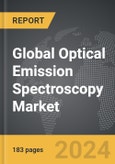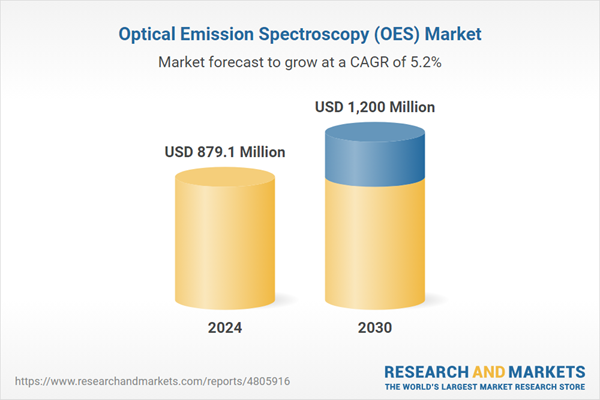The global market for Optical Emission Spectroscopy (OES) was valued at US$879.1 Million in 2024 and is projected to reach US$1.2 Billion by 2030, growing at a CAGR of 5.2% from 2024 to 2030. This comprehensive report provides an in-depth analysis of market trends, drivers, and forecasts, helping you make informed business decisions. The report includes the most recent global tariff developments and how they impact the Optical Emission Spectroscopy (OES) market.
Segments: Offering (Equipment, Services); Detector Type (Solid State Detector (SSD), Photomultiplier Tube (PMT), Hybrid).
Geographic Regions/Countries: World; United States; Canada; Japan; China; Europe (France; Germany; Italy; United Kingdom; and Rest of Europe); Asia-Pacific; Rest of World.
The analysts continuously track trade developments worldwide, drawing insights from leading global economists and over 200 industry and policy institutions, including think tanks, trade organizations, and national economic advisory bodies. This intelligence is integrated into forecasting models to provide timely, data-driven analysis of emerging risks and opportunities.
Global Optical Emission Spectroscopy (OES) Market - Key Trends & Drivers Summarized
How Is Optical Emission Spectroscopy (OES) Advancing Material Analysis?
Optical Emission Spectroscopy (OES) is a powerful analytical technique used to determine the elemental composition of materials, particularly metals and alloys. By analyzing the light emitted from a sample when it is excited by an energy source, OES can provide highly accurate and rapid identification of chemical elements present in the sample. OES is widely used in industries such as metallurgy, manufacturing, environmental monitoring, and chemical processing for quality control, compliance testing, and material characterization. In the steel and automotive industries, OES plays a crucial role in ensuring that metal alloys meet the required specifications for strength, durability, and corrosion resistance. With the increasing demand for high-quality materials in sectors like aerospace, automotive, and electronics, the need for precise and efficient material analysis tools like OES is growing.What Trends Are Driving the Optical Emission Spectroscopy Market?
Several trends are shaping the optical emission spectroscopy (OES) market, particularly the growing demand for real-time, accurate material analysis in industrial applications. One of the most significant trends is the increasing use of OES in quality control and regulatory compliance across industries such as manufacturing, metallurgy, and chemical processing. As industries face stricter regulations regarding material composition and environmental safety, OES is becoming a vital tool for ensuring compliance with international standards. Another trend is the rise of portable and handheld OES devices, which are gaining popularity due to their flexibility and ease of use in field applications, particularly in mining, recycling, and environmental monitoring. The push toward automation and Industry 4.0 is also driving demand for OES systems that can be integrated into automated production lines for real-time monitoring and quality assurance.How Is Technology Enhancing Optical Emission Spectroscopy?
Technological advancements are significantly improving the capabilities and efficiency of optical emission spectroscopy (OES). The development of more sensitive and accurate detectors has enhanced the precision of OES measurements, enabling the detection of trace elements at lower concentrations. Advances in excitation sources, such as inductively coupled plasma (ICP) and laser-induced breakdown spectroscopy (LIBS), are allowing for faster and more efficient sample excitation, improving the overall speed and accuracy of OES analyses. Additionally, the miniaturization of OES systems has led to the development of portable and handheld devices, making it easier to perform on-site material analysis in field applications. Automation and integration with digital technologies, such as IoT and cloud-based platforms, are enabling OES systems to be used in real-time, continuous monitoring of industrial processes, helping manufacturers improve product quality and reduce waste. The use of advanced data analytics and machine learning is also enhancing the interpretation of OES data, enabling more accurate and actionable insights from the analysis.What Is Driving the Growth in the Optical Emission Spectroscopy Market?
The growth in the optical emission spectroscopy (OES) market is driven by several factors, particularly the increasing demand for precise and reliable material analysis in industries such as metallurgy, manufacturing, and environmental monitoring. The need for accurate quality control and regulatory compliance in sectors such as automotive, aerospace, and construction is fueling the adoption of OES systems to ensure that materials meet stringent industry standards. The rising focus on sustainability and recycling is also driving demand for OES in the analysis of metals and alloys recovered from scrap materials. Technological advancements, such as the development of portable OES devices and the integration of OES with automation and digital platforms, are further supporting market growth by making the technology more accessible and versatile. Additionally, the expansion of industries in emerging markets is contributing to the demand for OES systems as manufacturers in these regions strive to meet global quality and environmental standards.Report Scope
The report analyzes the Optical Emission Spectroscopy (OES) market, presented in terms of units. The analysis covers the key segments and geographic regions outlined below.Segments: Offering (Equipment, Services); Detector Type (Solid State Detector (SSD), Photomultiplier Tube (PMT), Hybrid).
Geographic Regions/Countries: World; United States; Canada; Japan; China; Europe (France; Germany; Italy; United Kingdom; and Rest of Europe); Asia-Pacific; Rest of World.
Key Insights:
- Market Growth: Understand the significant growth trajectory of the Equipment segment, which is expected to reach US$718.1 Million by 2030 with a CAGR of a 4.8%. The Services segment is also set to grow at 5.9% CAGR over the analysis period.
- Regional Analysis: Gain insights into the U.S. market, valued at $239.6 Million in 2024, and China, forecasted to grow at an impressive 4.9% CAGR to reach $187.4 Million by 2030. Discover growth trends in other key regions, including Japan, Canada, Germany, and the Asia-Pacific.
Why You Should Buy This Report:
- Detailed Market Analysis: Access a thorough analysis of the Global Optical Emission Spectroscopy (OES) Market, covering all major geographic regions and market segments.
- Competitive Insights: Get an overview of the competitive landscape, including the market presence of major players across different geographies.
- Future Trends and Drivers: Understand the key trends and drivers shaping the future of the Global Optical Emission Spectroscopy (OES) Market.
- Actionable Insights: Benefit from actionable insights that can help you identify new revenue opportunities and make strategic business decisions.
Key Questions Answered:
- How is the Global Optical Emission Spectroscopy (OES) Market expected to evolve by 2030?
- What are the main drivers and restraints affecting the market?
- Which market segments will grow the most over the forecast period?
- How will market shares for different regions and segments change by 2030?
- Who are the leading players in the market, and what are their prospects?
Report Features:
- Comprehensive Market Data: Independent analysis of annual sales and market forecasts in US$ Million from 2024 to 2030.
- In-Depth Regional Analysis: Detailed insights into key markets, including the U.S., China, Japan, Canada, Europe, Asia-Pacific, Latin America, Middle East, and Africa.
- Company Profiles: Coverage of players such as Agilent Technologies, Inc., AMETEK, Inc., Analytik Jena AG, Bruker Corporation, Bureau Veritas SA and more.
- Complimentary Updates: Receive free report updates for one year to keep you informed of the latest market developments.
Some of the 19 companies featured in this Optical Emission Spectroscopy (OES) market report include:
- Agilent Technologies, Inc.
- AMETEK, Inc.
- Analytik Jena AG
- Bruker Corporation
- Bureau Veritas SA
- Element Materials Technology
- Focused Photonics, Inc.
- G.N.R. S.r.l. - Analytical Instruments Group
- GBC Scientific Equipment Pty., Ltd.
- Hitachi High-Technologies Corporation
- Horiba Ltd.
- Intertek Group PLC
- PerkinElmer, Inc.
- SGS SA
- Shimadzu Corporation
- Skyray Instrument Inc.
- Spectro Scientific Inc.
- Teledyne Leeman Labs
- Thermo Fisher Scientific, Inc.
- TUV Rheinland AG
- Tuv Sud AG
Tariff Impact Analysis: Key Insights for 2025
Global tariff negotiations across 180+ countries are reshaping supply chains, costs, and competitiveness. This report reflects the latest developments as of April 2025 and incorporates forward-looking insights into the market outlook.The analysts continuously track trade developments worldwide, drawing insights from leading global economists and over 200 industry and policy institutions, including think tanks, trade organizations, and national economic advisory bodies. This intelligence is integrated into forecasting models to provide timely, data-driven analysis of emerging risks and opportunities.
What’s Included in This Edition:
- Tariff-adjusted market forecasts by region and segment
- Analysis of cost and supply chain implications by sourcing and trade exposure
- Strategic insights into geographic shifts
Buyers receive a free July 2025 update with:
- Finalized tariff impacts and new trade agreement effects
- Updated projections reflecting global sourcing and cost shifts
- Expanded country-specific coverage across the industry
Table of Contents
I. METHODOLOGYII. EXECUTIVE SUMMARY2. FOCUS ON SELECT PLAYERSIII. MARKET ANALYSISIV. COMPETITION
1. MARKET OVERVIEW
3. MARKET TRENDS & DRIVERS
4. GLOBAL MARKET PERSPECTIVE
UNITED STATES
CANADA
JAPAN
CHINA
EUROPE
FRANCE
GERMANY
ITALY
UNITED KINGDOM
REST OF EUROPE
ASIA-PACIFIC
REST OF WORLD
Companies Mentioned (Partial List)
A selection of companies mentioned in this report includes, but is not limited to:
- Agilent Technologies, Inc.
- AMETEK, Inc.
- Analytik Jena AG
- Bruker Corporation
- Bureau Veritas SA
- Element Materials Technology
- Focused Photonics, Inc.
- G.N.R. S.r.l. - Analytical Instruments Group
- GBC Scientific Equipment Pty., Ltd.
- Hitachi High-Technologies Corporation
- Horiba Ltd.
- Intertek Group PLC
- PerkinElmer, Inc.
- SGS SA
- Shimadzu Corporation
- Skyray Instrument Inc.
- Spectro Scientific Inc.
- Teledyne Leeman Labs
- Thermo Fisher Scientific, Inc.
- TUV Rheinland AG
- Tuv Sud AG
Table Information
| Report Attribute | Details |
|---|---|
| No. of Pages | 183 |
| Published | April 2025 |
| Forecast Period | 2024 - 2030 |
| Estimated Market Value ( USD | $ 879.1 Million |
| Forecasted Market Value ( USD | $ 1200 Million |
| Compound Annual Growth Rate | 5.2% |
| Regions Covered | Global |









